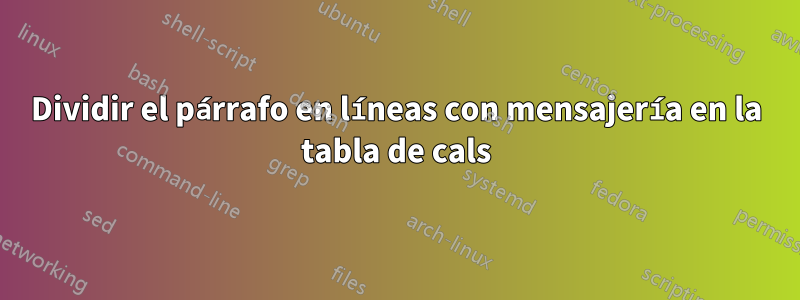
\documentclass[10pt,a4paper]{article}
\usepackage[utf8]{inputenc}
\usepackage[a4paper]{geometry}
\geometry{top=10mm, bottom=10mm, left=10mm, right=10mm}
\geometry{showframe}
\usepackage{courier}
\usepackage[T1]{fontenc}
\usepackage{cals}
\makeatletter
\begin{document}
%\renewcommand*\familydefault{\sfdefault}
\renewcommand*\familydefault{\ttdefault}
\normalfont
\begin{calstable}
\colwidths{
{15pt}
{10pt}
{515.60239pt}
}
\cals@paddingL=1pt
\cals@paddingR=1pt
\def\cals@borderT{0.2pt}
\def\cals@borderB{0.2pt}
\def\cals@borderL{0.2pt}
\def\cals@borderR{0.2pt}
\brow
\alignR \cell{\strut E}
\alignC \cell{\strut =}
\alignL \cell{\strut this is the english text, this is the english text, this is the english text, this is the english text, this is the english text, this is the english text, this is the english text}
\erow
\end{calstable}
Why doesn't the text break in the rigth place? In case of using sfdeault, it's good.
\end{document}
Respuesta1
Esto es similar aCómo hacer que las secciones largas de \texttt se rompan. De forma predeterminada, la ttfuente no tiene espacios entre palabras extensibles, por lo que TeX no tiene mucho espacio para maniobrar al elegir saltos de línea. Agregar algo de elasticidad mejora el salto de línea:

\documentclass[10pt,a4paper]{article}
\usepackage[utf8]{inputenc}
\usepackage[a4paper]{geometry}
\geometry{top=10mm, bottom=10mm, left=10mm, right=10mm}
\geometry{showframe}
\usepackage{courier}
\usepackage[T1]{fontenc}
\usepackage{cals}
\makeatletter
\newcommand*\flextt{%
\ttfamily
\fontdimen2\font=0.4em% interword space
\fontdimen3\font=0.2em% interword stretch
\fontdimen4\font=0.1em% interword shrink
\fontdimen7\font=0.1em% extra space
}
\begin{document}
\flextt
\begin{calstable}
\colwidths{
{15pt}
{10pt}
{515.60239pt}
}
\cals@paddingL=1pt
\cals@paddingR=1pt
\def\cals@borderT{0.2pt}
\def\cals@borderB{0.2pt}
\def\cals@borderL{0.2pt}
\def\cals@borderR{0.2pt}
\brow
\alignR \cell{\strut E}
\alignC \cell{\strut =}
\alignL \cell{\strut this is the english text, this is the english text, this is the english text, this is the english text, this is the english text, this is the english text, this is the english text}
\erow
\end{calstable}
Why doesn't the text break in the rigth place? In case of using sfdeault, it's good.
\end{document}
Respuesta2
Siempre es un gran problema intentar dividir palabras en ttfuentes.
Puedes intentar usar un sloppyparentorno:
\documentclass[10pt,a4paper]{article}
\usepackage[utf8]{inputenc}
\usepackage[a4paper]{geometry}
\geometry{top=10mm, bottom=10mm, left=10mm, right=10mm}
\geometry{showframe}
\usepackage{courier}
\usepackage[T1]{fontenc}
\usepackage{cals}
\makeatletter
\begin{document}
%\renewcommand*\familydefault{\sfdefault}
\renewcommand*\familydefault{\ttdefault}
\normalfont
\begin{calstable}
\colwidths{
{15pt}
{10pt}
{515.50239pt}
}
\cals@paddingL=1pt
\cals@paddingR=1pt
\def\cals@borderT{0.2pt}
\def\cals@borderB{0.2pt}
\def\cals@borderL{0.2pt}
\def\cals@borderR{0.2pt}
\brow
\alignR \cell{\strut E}
\alignC \cell{\strut =}
\alignL \cell{\begin{sloppypar}\strut this is the english text, this is the english text,
this is the english text, this is the english text, this is the english text,
this is the english text, this is the english text\end{sloppypar}}
\erow
\end{calstable}
Why doesn't the text break in the rigth place? In case of using sfdeault, it's good.
\end{document}
Producción:



